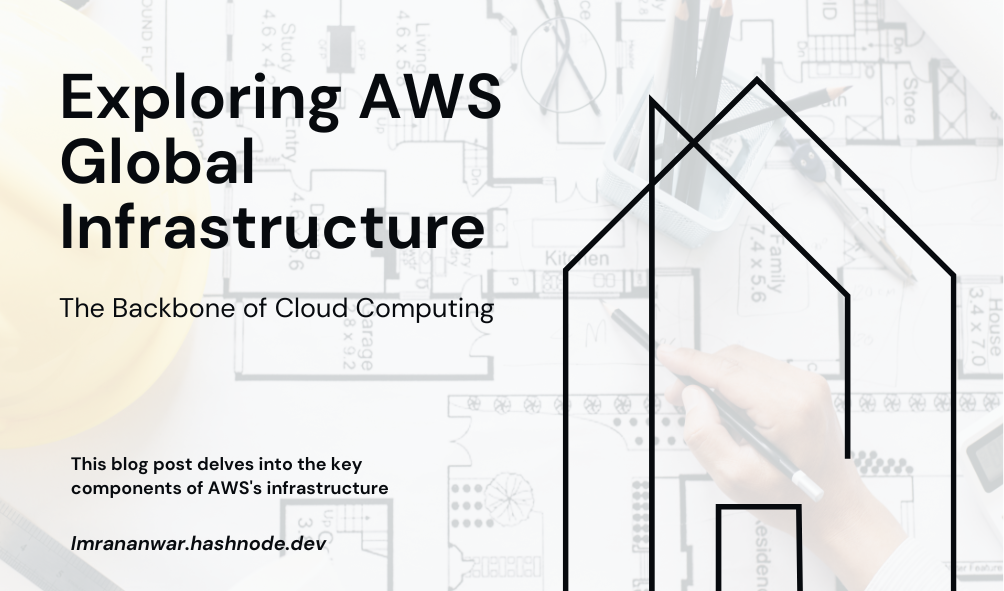Exploring AWS Global Infrastructure
 Imran Anwar
Imran Anwar
The Backbone of Cloud Computing
In today's digital era, the global reach and reliability of cloud services are paramount. Amazon Web Services (AWS) stands out as a leader in this domain, thanks to its expansive and meticulously designed global infrastructure. This blog post delves into the key components of AWS's infrastructure, highlighting how it ensures high availability, scalability, and low latency for its users worldwide.
Understanding AWS Global Infrastructure
AWS's global infrastructure is composed of multiple key elements: Regions, Availability Zones (AZs), Edge Locations, Local Zones, and Wavelength Zones. Each component plays a vital role in delivering AWS services efficiently and reliably.
1. AWS Regions
Regions are physical locations around the globe where AWS clusters data centers. Each region is a separate geographic area.
Geographic Distribution: AWS boasts over 30 regions across North America, South America, Europe, Asia Pacific, and the Middle East.
Autonomy: Every region operates independently to ensure maximum fault tolerance and stability.
Regional Services: Some AWS services are specific to certain regions to comply with local laws and regulations.
2. Availability Zones (AZs)
Availability Zones are clusters of data centers within a region. They are designed to be independent from one another to prevent issues in one AZ from affecting others.
Redundancy and Reliability: Each region contains multiple AZs, usually three or more, ensuring redundancy.
Low Latency: AZs within a region are interconnected with high-speed, private fiber-optic networks, offering low-latency performance.
3. Edge Locations
Edge Locations are data centers designed to deliver content closer to users, reducing latency.
Content Delivery: Utilized by Amazon CloudFront, AWS's content delivery network (CDN), to deliver content with low latency.
Global Reach: With over 400 edge locations globally, AWS ensures optimal performance and quick access.
4. Local Zones
Local Zones are extensions of AWS regions that place compute, storage, database, and other services closer to end-users.
Low-Latency Access: Ideal for applications requiring single-digit millisecond latency in specific areas.
Hybrid Cloud: Local Zones extend AWS infrastructure closer to customer premises, enhancing hybrid cloud solutions.
5. Wavelength Zones
Wavelength Zones embed AWS infrastructure within telecom providers' data centers to support 5G networks.
5G Integration: Provides seamless access to AWS services over 5G networks.
Ultra-Low Latency: Perfect for applications needing ultra-low latency, such as real-time gaming, AR/VR, and machine learning inference at the edge.
Benefits of AWS Global Infrastructure
AWS's global infrastructure offers numerous benefits that make it a preferred choice for businesses of all sizes:
High Availability: Multiple regions and AZs ensure high availability and fault tolerance.
Scalability: Effortlessly scale applications up or down across different regions based on demand.
Compliance and Data Sovereignty: Regions help businesses comply with data locality laws and regulations.
Global Reach with Local Performance: Edge locations and Local Zones enhance user experience by reducing latency.
Use Cases
AWS's global infrastructure supports a variety of use cases, enabling businesses to leverage its extensive network:
Disaster Recovery: Deploy applications across multiple regions and AZs for robust disaster recovery solutions.
Global Applications: Host applications closer to users worldwide, ensuring reduced latency and improved performance.
Regulatory Requirements: Store and process data in specific geographic locations to meet regulatory requirements.
Conclusion
AWS's global infrastructure is a testament to its commitment to delivering reliable, scalable, and low-latency cloud services. By strategically distributing its data centers across the globe and integrating advanced technologies like 5G, AWS ensures that businesses can operate seamlessly, no matter where they are located. Whether you are building a simple application or a complex enterprise system, AWS's infrastructure provides the foundation you need to succeed in the cloud.
Subscribe to my newsletter
Read articles from Imran Anwar directly inside your inbox. Subscribe to the newsletter, and don't miss out.
Written by

Imran Anwar
Imran Anwar
"My name is Imran Anwar, currently a third-year BTech student majoring in Computer Science and Engineering. While I am still in the process of gaining professional experience, my ambition is to excel as a DevOps Engineer specializing in cloud infrastructure. I have a keen interest and foundational knowledge in AWS, with aspirations to design, implement, and manage highly scalable architectures using core services such as EC2, S3, RDS, and Lambda. I am proficient in infrastructure as code tools like Terraform and CloudFormation and have hands-on experience setting up CI/CD pipelines using Jenkins and AWS CodePipeline. Additionally, my skills extend to container orchestration using Docker and Kubernetes, and I have implemented robust monitoring solutions using CloudWatch and Elasticsearch. I pride myself on being a quick learner and a problem solver, consistently seeking opportunities to expand my skill set and tackle challenges head-on. My strong communication and collaboration skills enable me to effectively engage with cross-functional teams, including developers and operations personnel. I am deeply passionate about cloud computing and am eager to leverage AWS services to drive innovation and deliver impactful business outcomes."